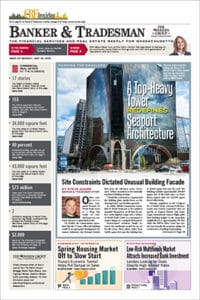
The economics of building rental housing make it easy to frighten off investors with the prospect of expanding rent control.
A new push by a pair of progressive state lawmakers to bring back rent control, if successful, would push Greater Boston’s already crazy rents even higher.
Overnight, it would pull the rug out from under the apartment boom, one that has seen a bevy of new rental high-rises take shape in Boston and Cambridge.
Think I’m blowing hot air? Just look at the record of what got built – or more accurately what didn’t – during the two decades rent control held sway in Boston, Cambridge and Brookline.
Threat of Expansion Scared Off Investors
From the early 1970s through the mid-1990s, downtown Boston saw just one new, market-rate apartment high-rise take shape downtown, the Devonshire in Downtown Crossing.
Think about that. Just one new apartment tower in two decades.
It wasn’t exactly like developers were sitting on their hands, especially in Boston. The 1970s and ’80s were the glory days of office tower development in Boston, and gave us local landmarks like the Hancock and International Place towers.
But developers who built office towers knew they were free to charge the rents they needed to charge to make a profit and pay back their investors.

Even though the 1970s and 1980s were the heyday of office tower construction in Boston, only one developer was brave enough to build an apartment tower in the city: Downtown Crossing’s The Devonshire. Photo courtesy of Solarapex / CC BY-SA 3.0
In theory, that should have been true in the apartment market as well, even with rent control. When Massachusetts lawmakers passed rent control in 1970, the legislation only applied to existing apartments, with new construction exempt from the cap on rent hikes.
Where do the Top Loan Originators Rank in Your Market?
You’re one click away from identifying top loan originators with The Warren Group’s Loan Originator Module! Measure loan origination and loan activity against competition and market activity, recruit leading purchase and non-purchase loan originators and identify loan originators for potential partnership and business relationships. Let us know your objectives, and we’ll connect you with this vital market intelligence to exceed your goals.
However, once control rent control was on the books and in force in Boston and Cambridge, it was enough to scare off most would-be apartment tower developers.
After all, finding investors to pony up hundreds of millions of dollars for a new apartment can be a tall order even in the best of times.
But with rent control, there was always the threat it could be extended at some point to include newer properties.
And unlike a condo tower, where units are sold in a year or two and the builder moves on, the payback for an apartment high-rise takes place over years and decades, and depends on the owner’s ability to raise rents.
Death of Rent Control Spurred Growth Explosion
However, it’s what happened after rental control was finally lifted in the 1990s that should drive a nail through the coffin of this misguided idea from state Reps. Nika Elugardo and Mike Connolly.
New residential construction exploded in Boston and Cambridge starting in the late 1990s and momentum has steadily built since then.
While there certainly has been a lot of luxury condo development, 14,400 new apartments also came online in the Boston area in 2017 and 2018.
Meanwhile, the next two years will see a veritable flood of high-priced new high-rises and buildings open their doors, with than 20,000 new apartments, albeit many of them luxury, expected to hit the market in Greater Boston over 2019 and 2020, according to commercial real estate data and research firm CoStar Group, Inc.
Overall rent growth is expected to slow by half this year to 1.4 percent, compared to 2.8 percent in 2018, CoStar reports.
New Supply a Key Restraint on Rents
Of course, all this new development has yet to dramatically lower rents which, understandably, is a source of frustration for many. But if would be unfair to say it hasn’t had an impact.
It’s also important not to lose track of the bigger picture.
While it certainly seems like a lot of new apartments are getting built, we are also having to make up for decades in which few new rentals came on the market.
And just getting to this point has been difficult. Rent control is hardly the only reason for the long drought in new apartment development, with NIMBY opposition to new housing and restrictive zoning having played critical roles.

Scott Van Voorhis
Greater Boston’s ever higher rents, coupled with our crushingly high home prices, threaten to push all but the very poor and the affluent out of town.
But rent control would make a bad problem even worse.
Sure, some people would benefit, though given how rent control worked the last time around, it’s not hard to imagine a new crop of scandals involving coveted units going to the politically connected, like former Cambridge Mayor Kenneth Reeves, who spent 20 years in a $421–a-month rent controlled flat.
But for everyone else, the market would get 10 times worse, with one of the few remaining restraints on rising rents – the addition of new supply – suddenly removed.
If you want to go back to one new apartment project built every 20 years then, by all means, get behind the push to bring back rent control.
But if you want to help keep Greater Boston’s middle- and working-class families from being priced out, forget about the idea.
Instead, get behind the construction of more housing of all types, especially apartments.
It’s far from a silver bullet, and it’s not going to improve things overnight, but it’s our only hope to get to a healthier – and fairer – real estate market.
Scott Van Voorhis is Banker & Tradesman’s columnist; opinions expressed are his own. He may be reached at sbvanvoorhis@hotmail.com.




